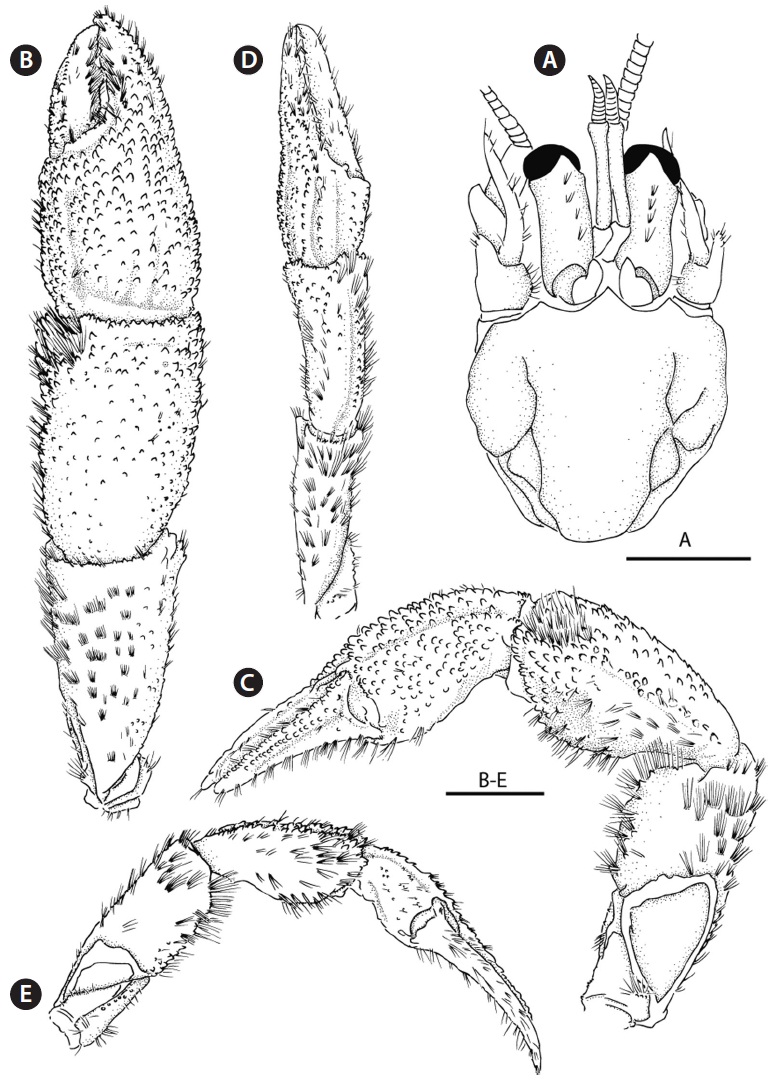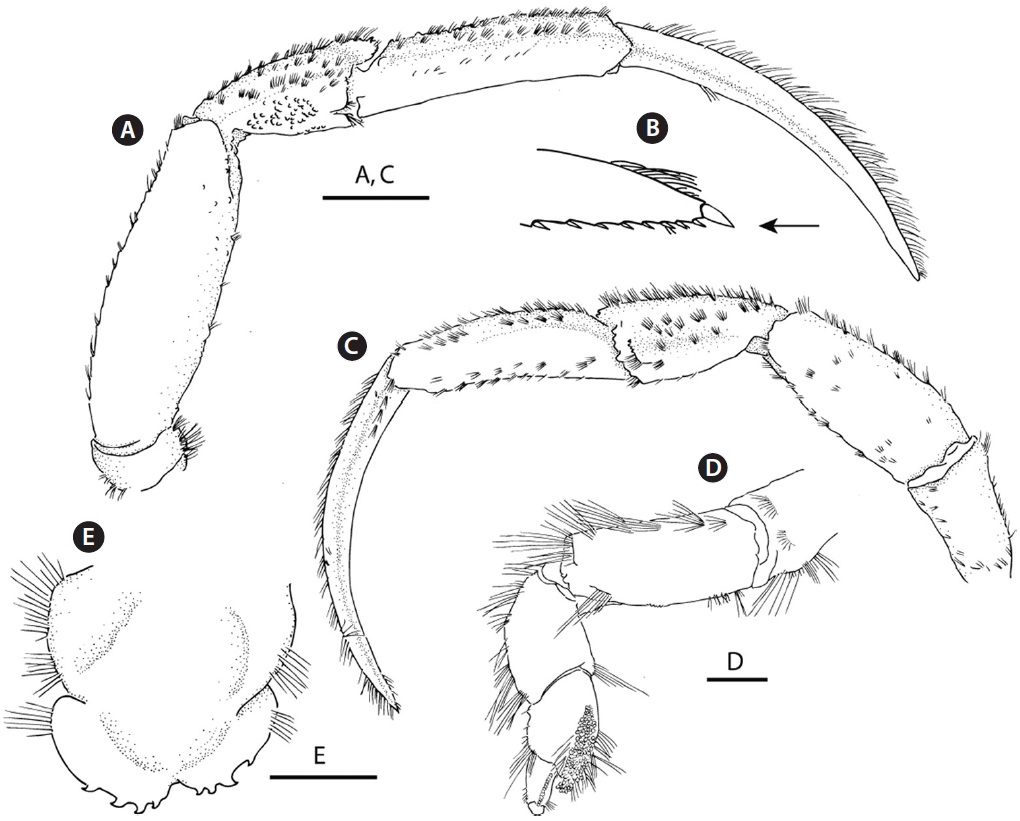



The genus
Terminology used here is mainly based on that of McLaughlin (2003). Shield length (sl) is used as an indication of the size of the specimen, measured from the tip of the rostrum to the midpoint of the posterior margin of the shield.
Two ♂♂ (sl 11.0, 14.0 mm), Imwon, Kangwon-do, East Sea, Korea, 1 Oct 2010, trawl from 500 m depth (PUIZ 165).
Order Decapoda Latreille, 1802
Family Paguridae Latreille, 1802
Genus Pagurus Fabricius, 1775
Shield (Fig. 1A) almost naked, as wide as or slightly broader than long; rostrum triangular, with overreaching broadly triangular lateral projections; anterior margin between rostrum and lateral projections concave. Ocular peduncle (Fig. 1A) 0.6 times as long as shield; each with a longitudinal row of short setae on the dorsomedial surface; corneas slightly dilated. Antennular peduncle (Fig. 1A) long, exceeding ocular peduncles by 0.75 length of ultimate segment with supernumerary segmentation. Antennal acicle long, usually reaching distal half of ultimate antennal segment. Right cheliped (Fig. 1B and 1C) considerably larger than the left. Chela (Fig. 1B) approximately twice as long as broad, subovate in dorsal view. Dactylus (Fig. 1B) approximately half that of palm length, usually leaving narrow hiatus when closed. Dorsal surface with small, simple granules and scattered very short setae; cutting edge with calcareous teeth proximally and small corneous teeth distally; terminating in strong corneous claw overlapped by a fixed finger. Fixed finger (Fig. 1B) with obtuse calcareous teeth proximally, terminating in small corneous or calcareous claw. Palm (Fig. 1B) longer than carpus; dorsal surface with small spines or tubercles; dorsolateral margin with a row of moderately prominent spines, increasing in size distally; mesial face with small-spines; ventral surface usually with simple or bifid, spinulose tubercles and tufts of setae (Fig. 1C). Carpus (Fig. 1B and 1C) almost equaling length of merus; dorsal surface scattered with small conical spines; dorsomesial distal angle with prominent shallow depression and several small spines obscured by a patch of dense, moderately long fine setae; ventral surface convex, with small blunt tubercles and tufts of setae. Merus (Fig. 1B and 1C) subtriangular; dorsal surface with irregular spinulose protuberances and tufts of short setae; dorsodistal
margin with slender spines; ventral surface with scattered small spines and tufts of setae. Left cheliped (Fig. 1D and 1E) slender and moderately shorter than right. Chela (Fig. 1D) about 2.7 times longer than wide. Dactylus (Fig. 1D) about twice as long as palm, with small spines and tufts of setae on the surface; cutting edge of fixed finger (Fig. 1D) with small calcareous teeth. Palm (Fig. 1D) approximately half as long as carpus with oblique, concave dorsolateral surface; dorsal surface elevated medially with moderately strong ridge armed with spines; dorsolateral margin with a single or double row of moderately prominent small spines. Carpus (Fig. 1D and 1E) almost equals length of merus; dorsal surface with small spinulose tubercles; dorsolateral and dorsomesial margins slightly elevated, each having a row of spines; long setae on a weakly convex ventral surface. Merus (Fig. 1D and 1E) subtriangular, slightly compressed laterally; dorsal surface with irregular spinulose protuberances and tufts of setae; ventral surface with scattered small spines and tufts of setae. Ambulatory legs (Fig. 2A-2C) moderately long, slightly overreaching right cheliped; dactyli longer than propodi, somewhat twisted, bearing a row of corneous spinules that become dense distally on almost entire length of ventral margins (Fig. 2B); dorsal margins of propodi and carpi not spinose with row of tufts of setae. Fourth pereopods (Fig. 2D) subchelate; propodal rasp composed of numerous corneous scales arranged irregularly. Telson (Fig. 2E) with posterior lobes slightly asymmetrical, separated by small median cleft; terminal margins each with four moderately strong spines.
Shield, posterior carapace, ocular peduncles and chelipeds generally reddish-orange; ambulatory legs generally light orange with darker bands at distal ends of propodi, carpi and meri.
East Sea, Sea of Okhotsk, Bering Sea, Chukchi Sea, Arctic Ocean to Point Barrow, Ibaraki Prefecture in northeastern Honshu, Japan; 9-500 m.


